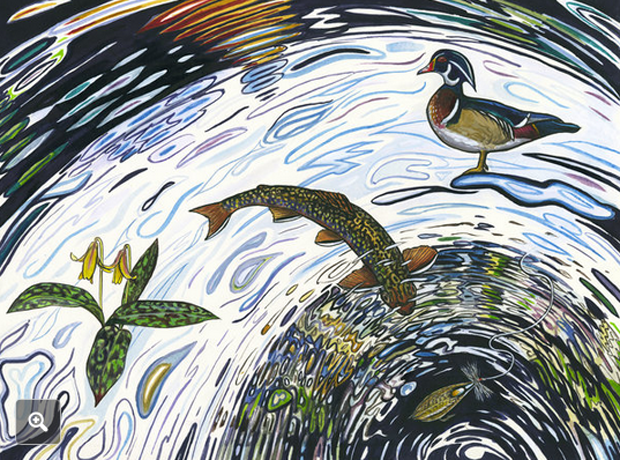Trout Fishing, a Taut Line to Our Past
APRIL 18, 2015 / New York Times
NOTE: James Prosek is an artist and writer living in Easton, Conn. He is working on a book about how and why we name and order the natural world, and currently has exhibitions at the North Carolina Museum of Art in Raleigh and the Leslie Feely gallery in Manhattan.
By JAMES PROSEK
[dropcap]T[/dropcap]o me, trout fishing, in particular fly-fishing, is many things, but above all, it is a conversation, a communication — with a creature to which we are connected by common ancestry not so very long ago (420 million years, give or take). The rod, the line and the hook are the tools of this communication, but the fly or lure is the ultimate translator between languages, between our world of names, structures, systems and hierarchies and theirs of instinct, impulse and experience. Trout fishing connects us not only to our ancestral past, but to our legacy as hunter-gatherers, to a time when we needed to catch and kill in order to survive. This, I have concluded after many years of doing it, must be primarily why we fish, to satisfy some latent impulse deep in our evolutionary fabric — even if now, as we release the fish, it is more of a kind of predatory performance art. (One could argue that many, or all, sporting activities are.) It is not, however, nor has it ever been, simply about the predation itself, but the whole assemblage of steps before and after, about engaging our senses with a larger interconnected whole (from anticipation and pursuit to the preparation and eventual ingestion of our prey).
We stand in the stream and we become part of the circulatory system of the planet — the rivulets, brooks, streams and rivers that pulse throughout our lands and connect the land to the sea, and those seas to other seas (and through water vapor and clouds, and migratory birds and fish, those seas back to the land). Through fishing, we can, for brief moments, achieve a kind of immortality when we step into this perpetual flow, and see our reflection in the water, and become part of it.
In spring, at the start of trout season, this flow is pulsing harder than ever. Snowmelt has filled the water table to overflowing, insects are emerging from their larval exoskeletons, birds are hatching from their eggs, spring wildflowers are unfolding from the ground, thrusting their heads through dry leaves. The eggs of brook trout, buried in the gravel by their parents the previous fall, are hatching, and tiny fish are trying their tails and pelvic fins in the cold currents. Spring fishing for trout allows us to participate in a physical and spiritual emergence, shed our winter coats and also our human skin, and melt into an experience that cannot be quantified or named.
Flies, the Durable Deceivers
The anglers’ art is artifice — using feathers and fur tied to a hook to imitate life. The methods evolved out of necessity: People witnessed trout eating insects that were too small and fragile to impale on a hook as bait and had to create durable counterparts to catch them. The earliest written account of fishing with an artificial fly is from Claudius Aelianus’s “De Natura Animalium” from the second century in Macedonia — although the tradition is very likely much older.
These translation devices are as beautiful and diverse as the fish they are meant to deceive. They imitate not only insects, but anything that might fall prey to a fish.
THE STREAMER is an elongated fly intended to attract fish when cast and retrieved. It can imitate any number of things, from a minnow to a large insect larva.
Continue reading the main story, play video and view Prosek’s drawings click here . . .
[information]
Read the New York Times online . . .
[/information]




